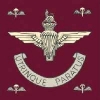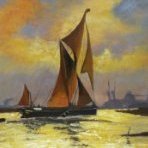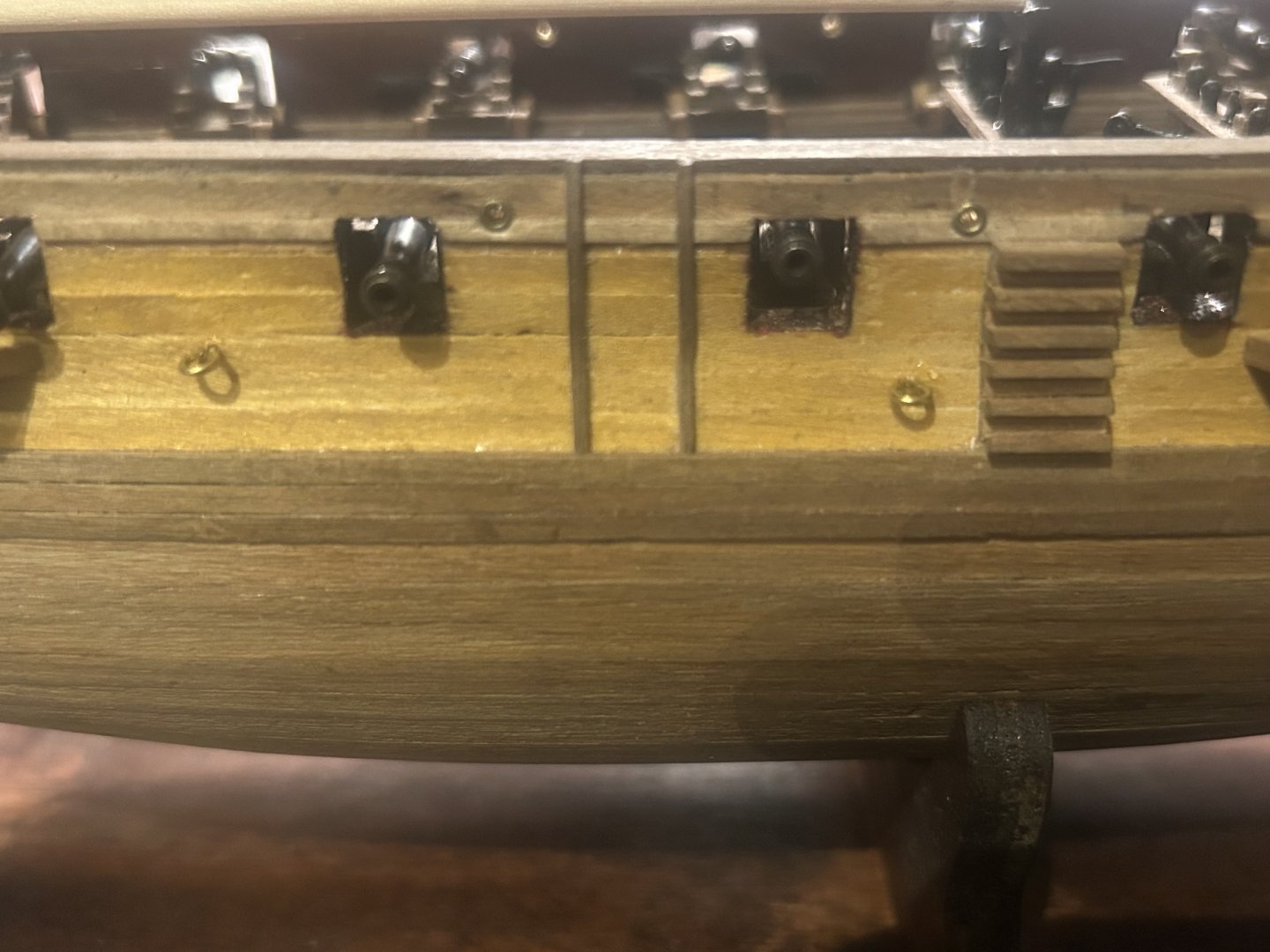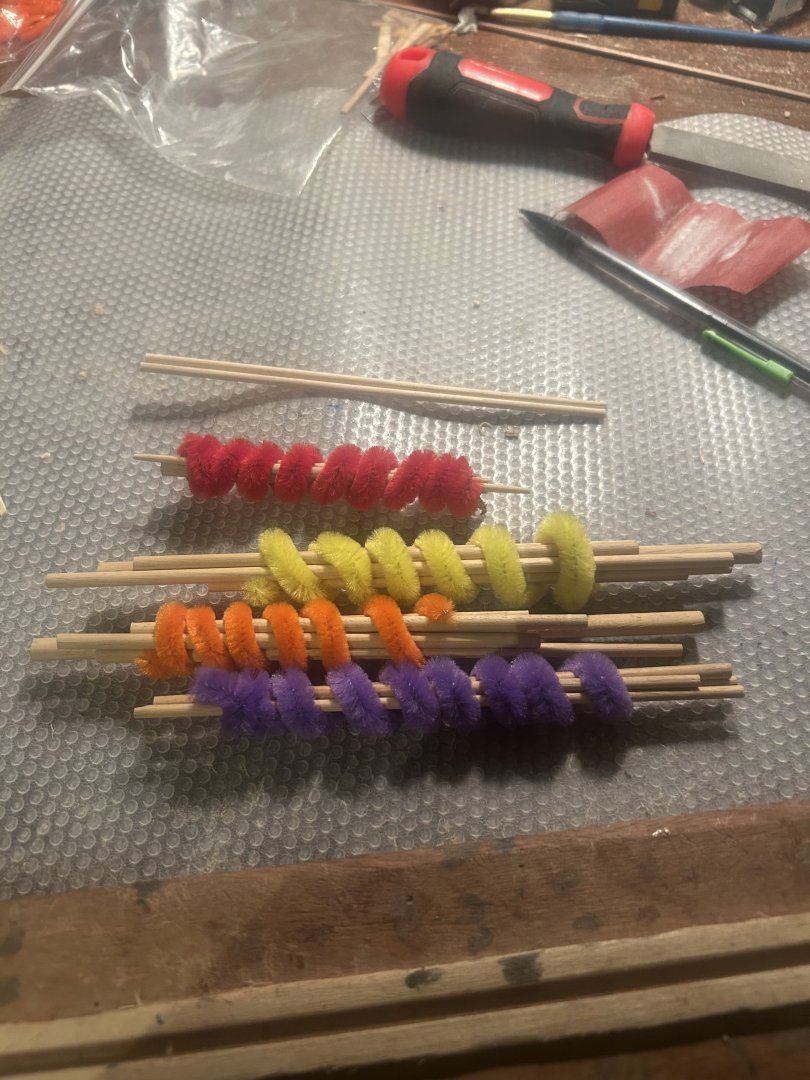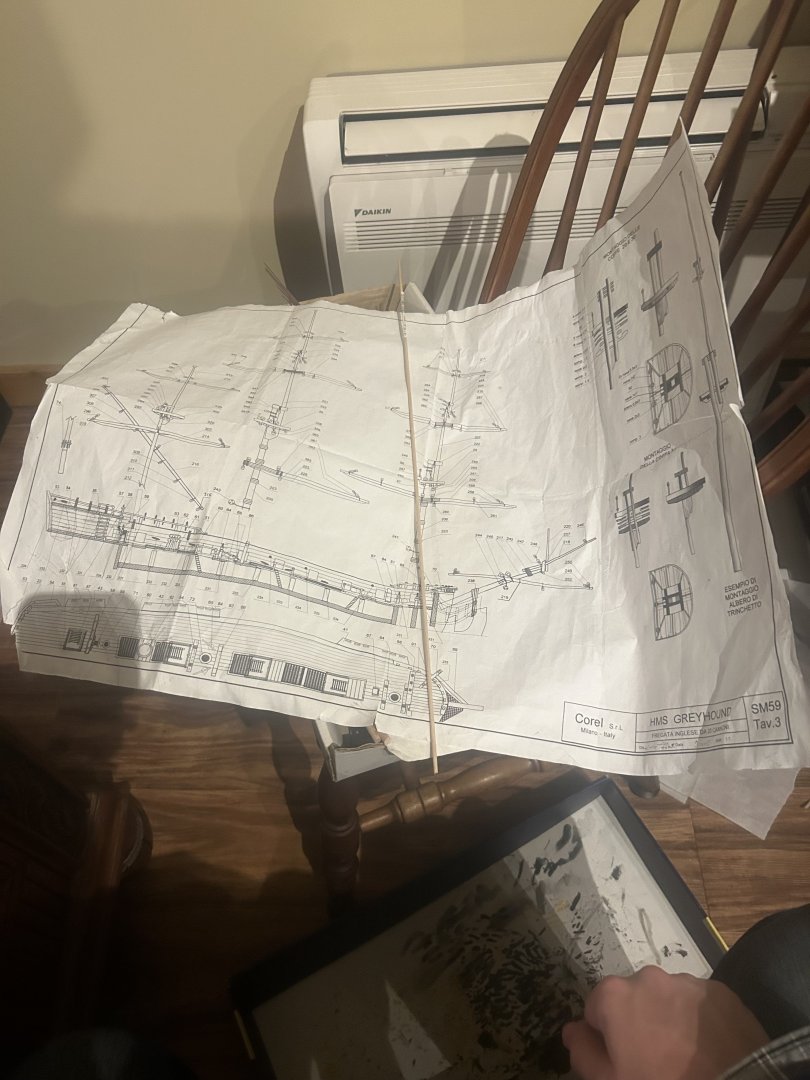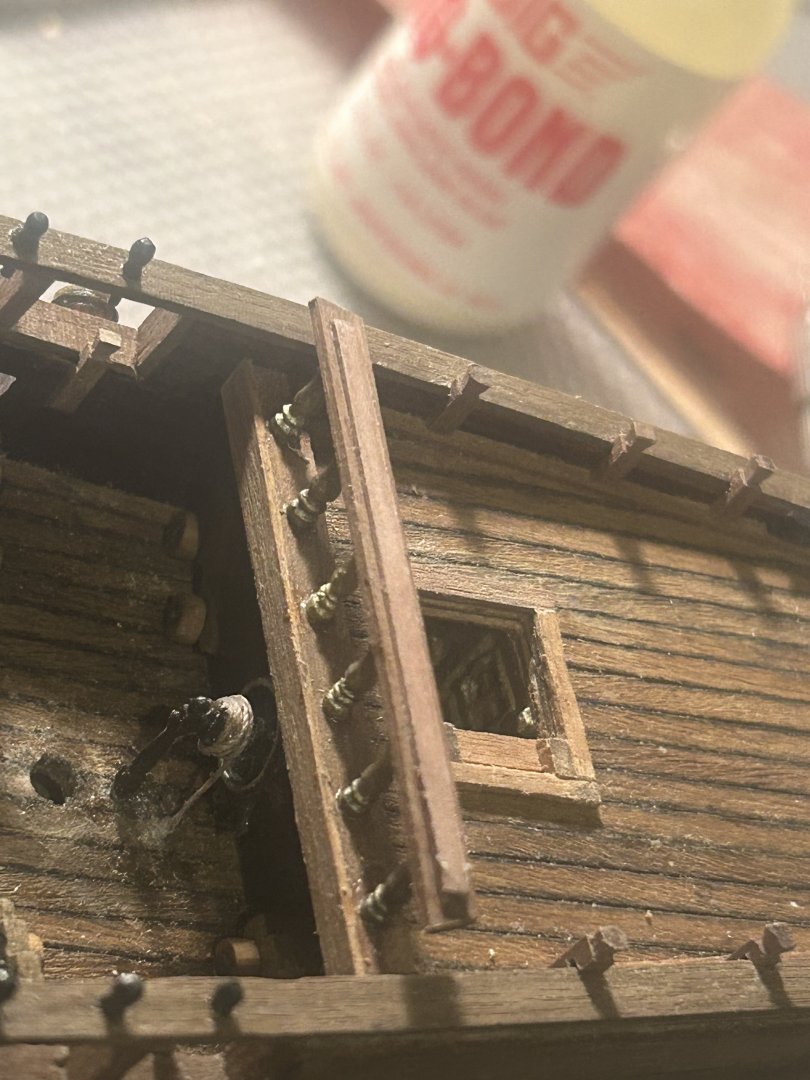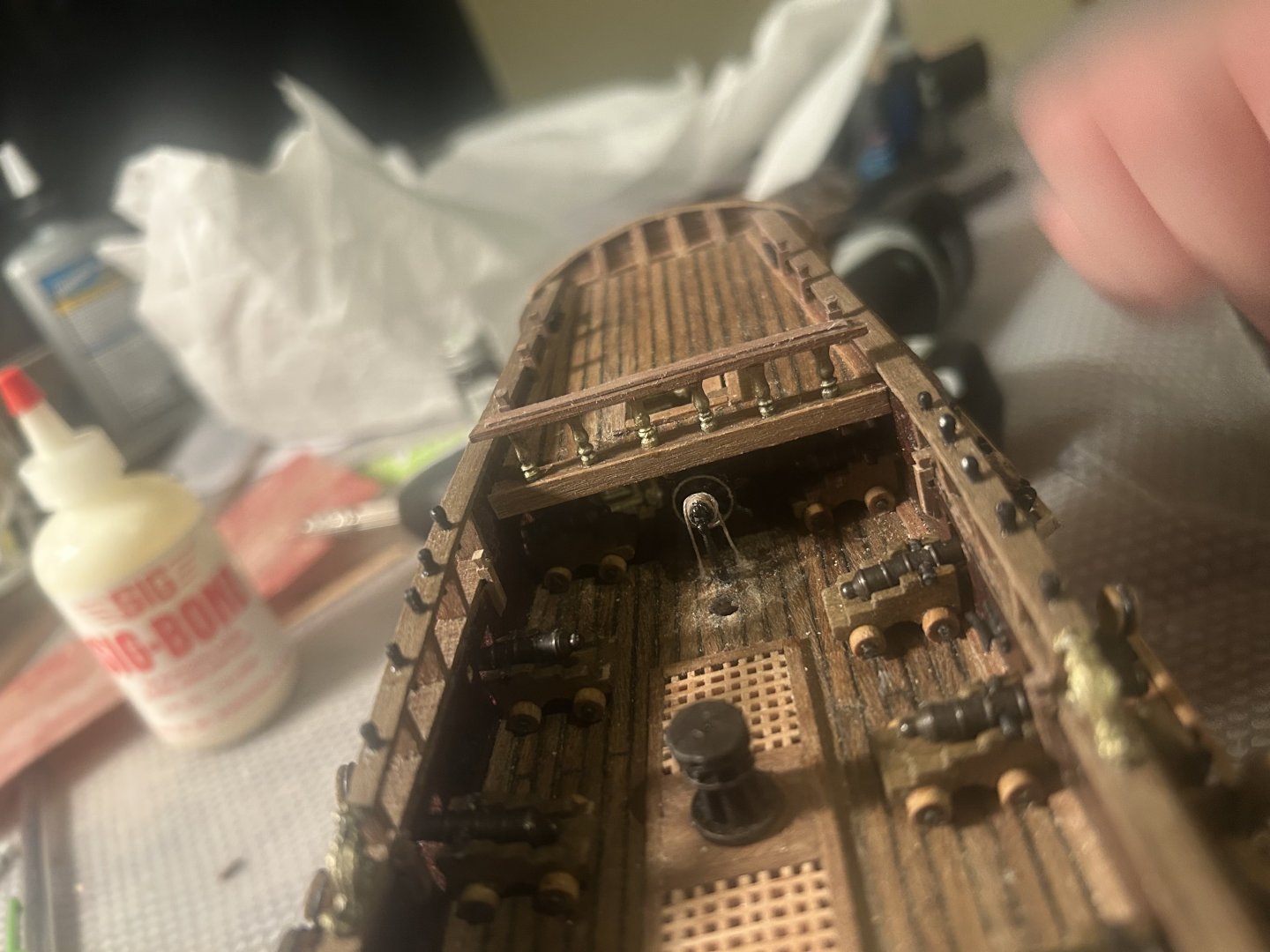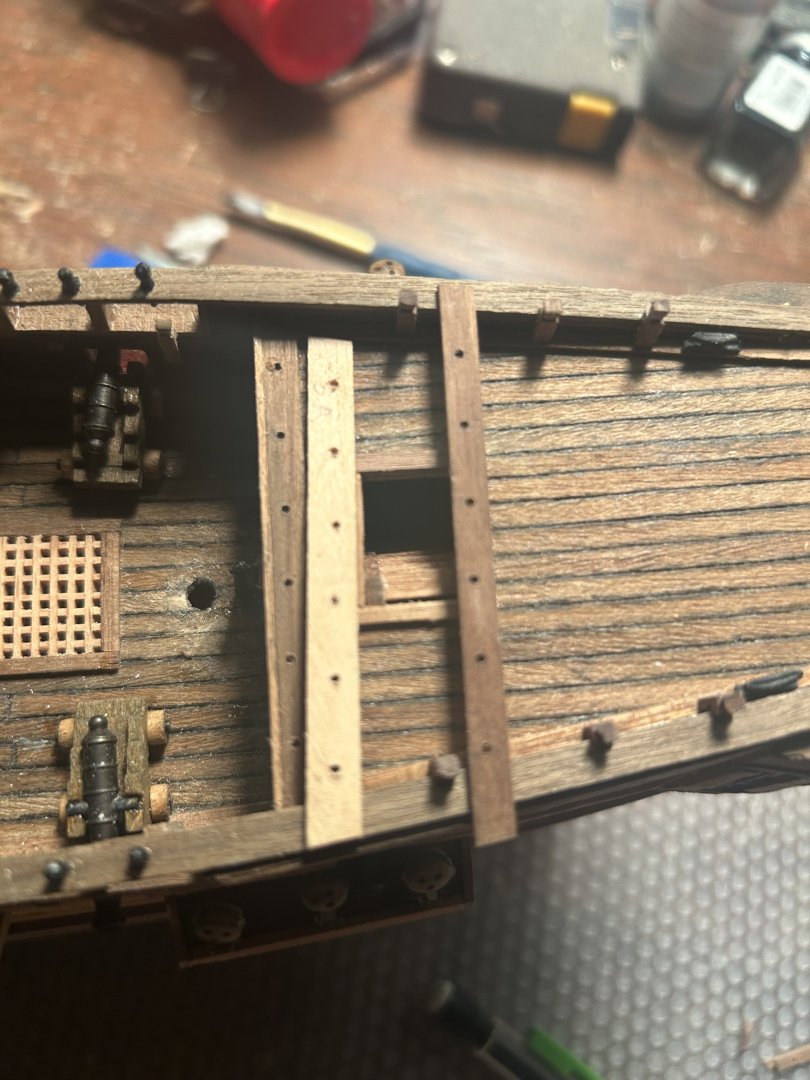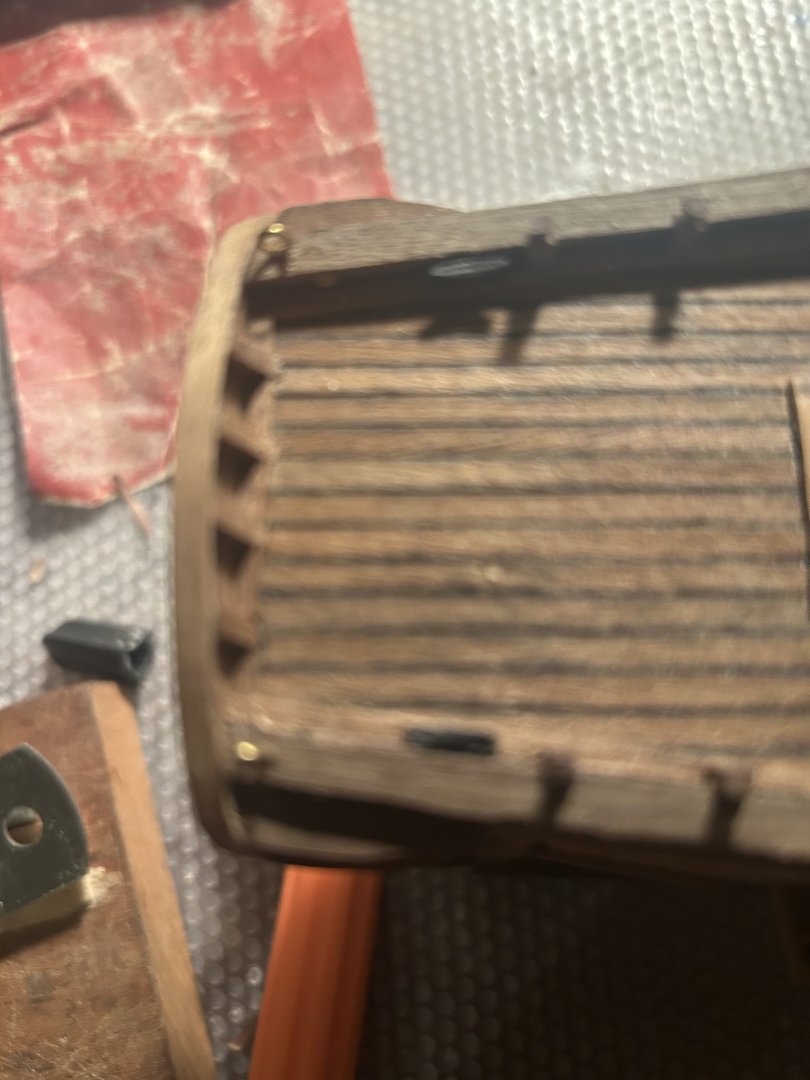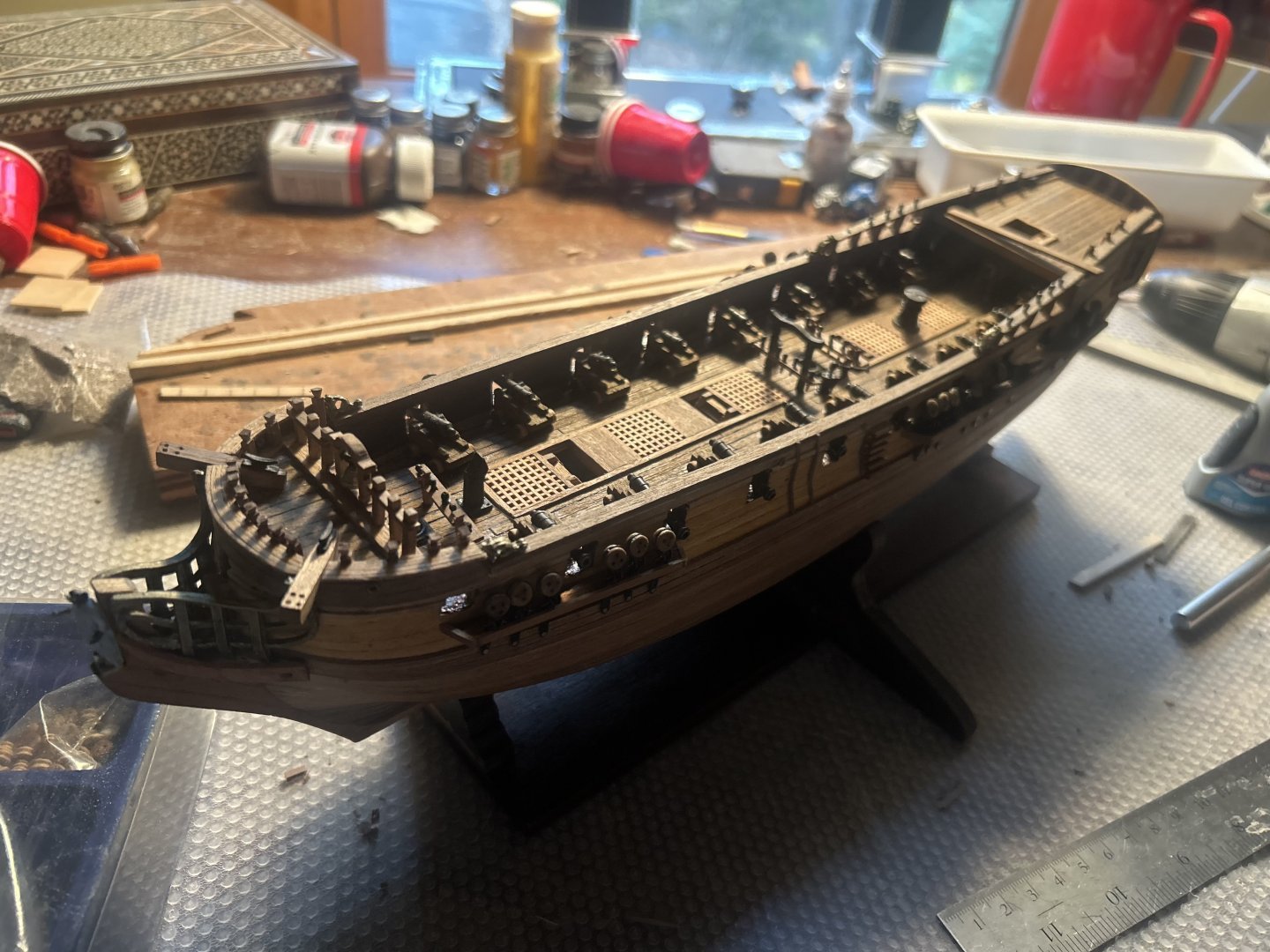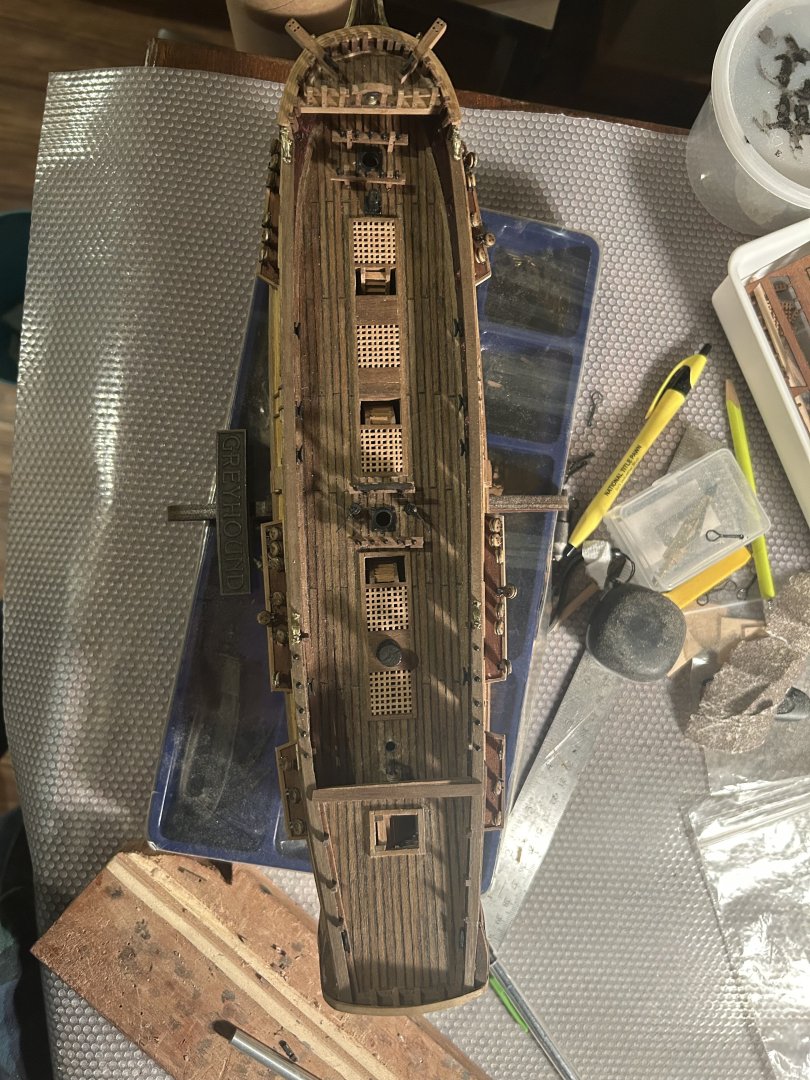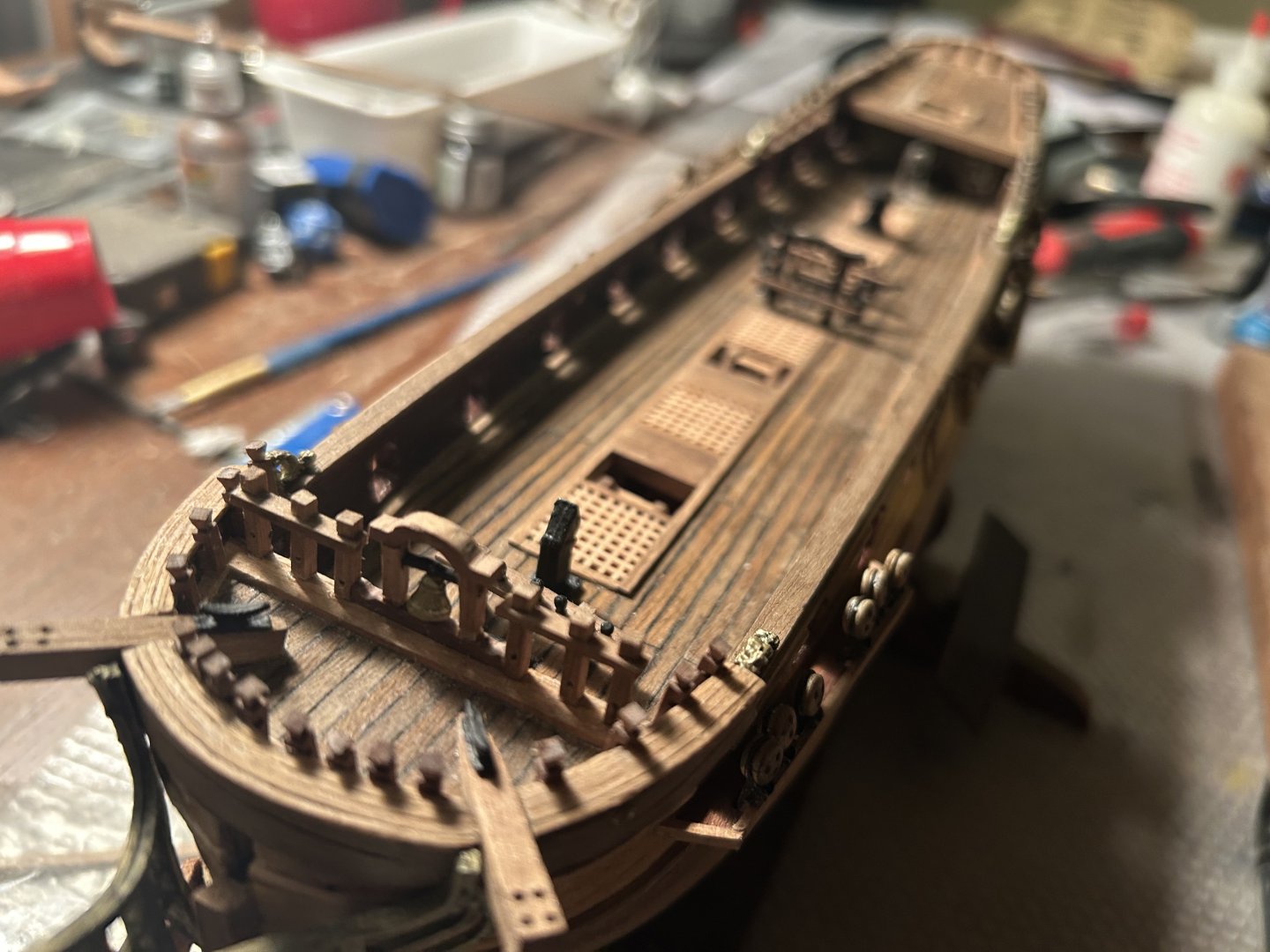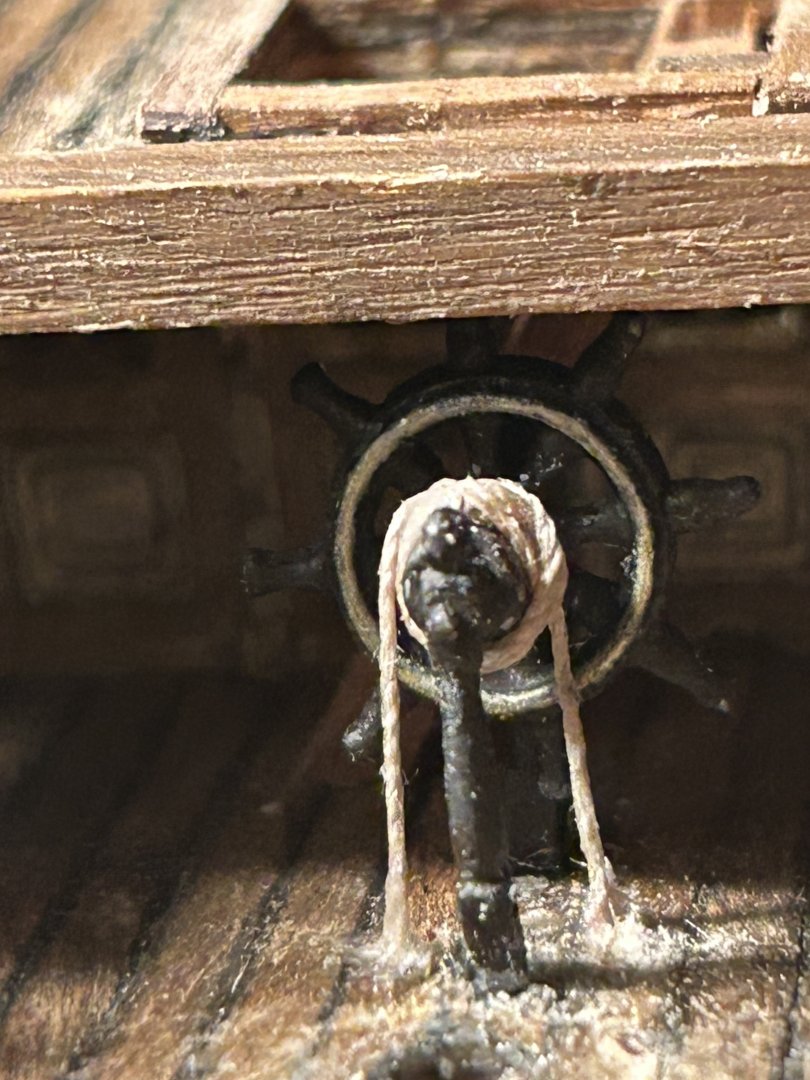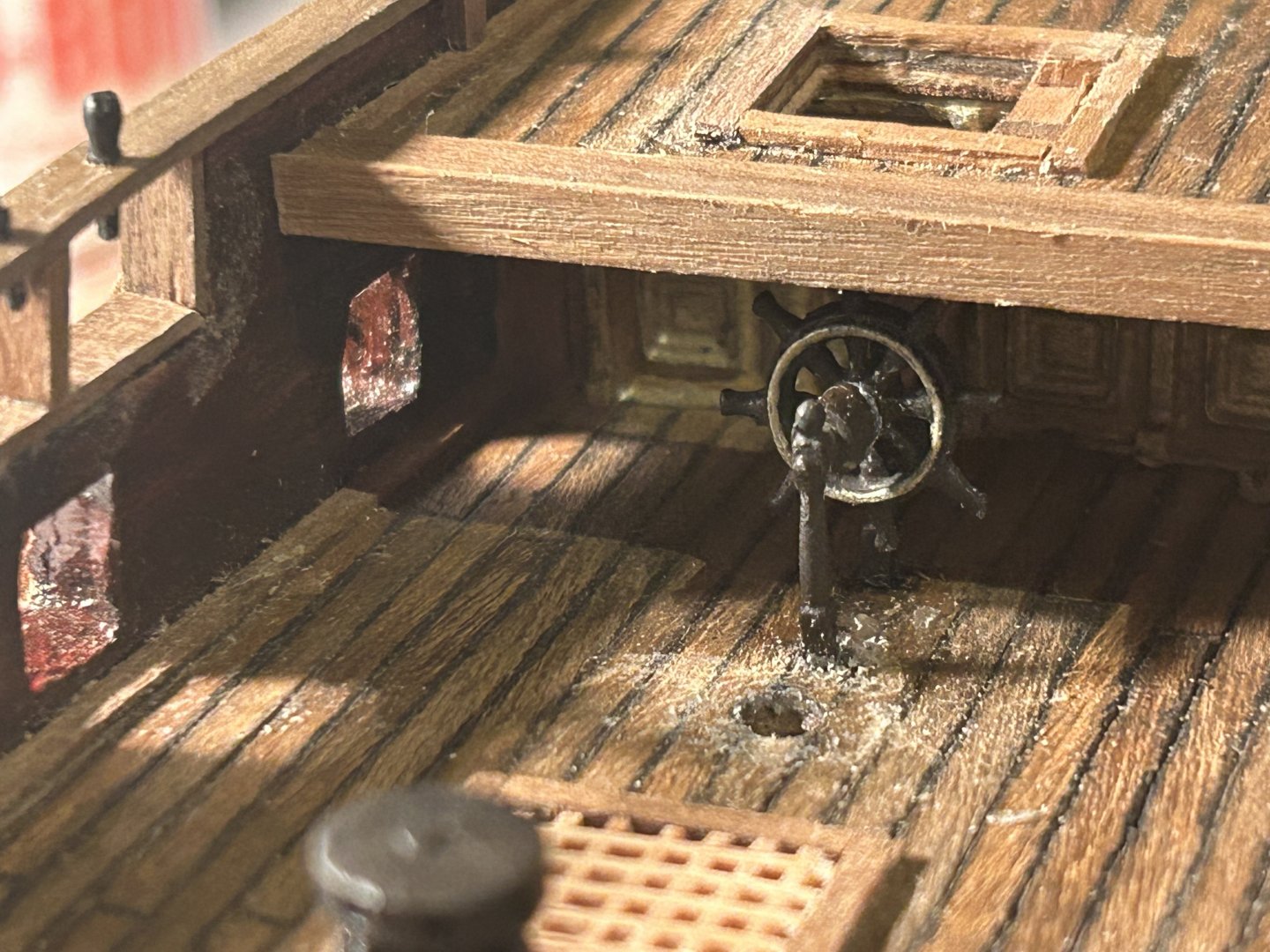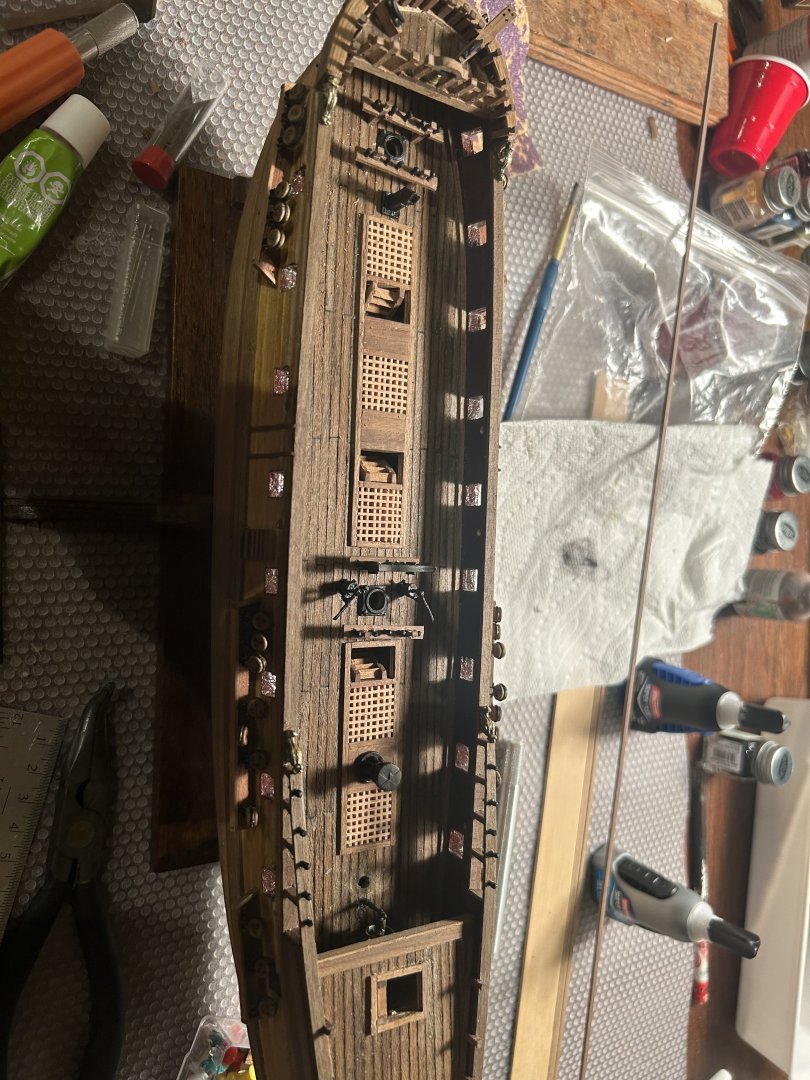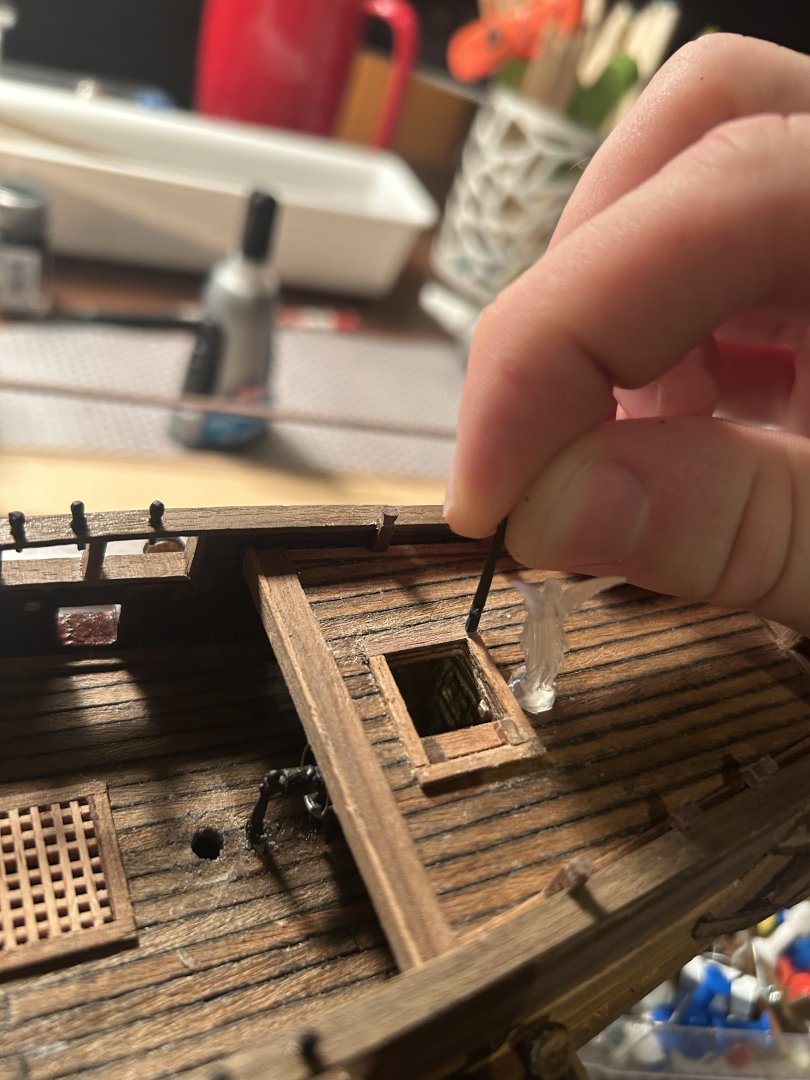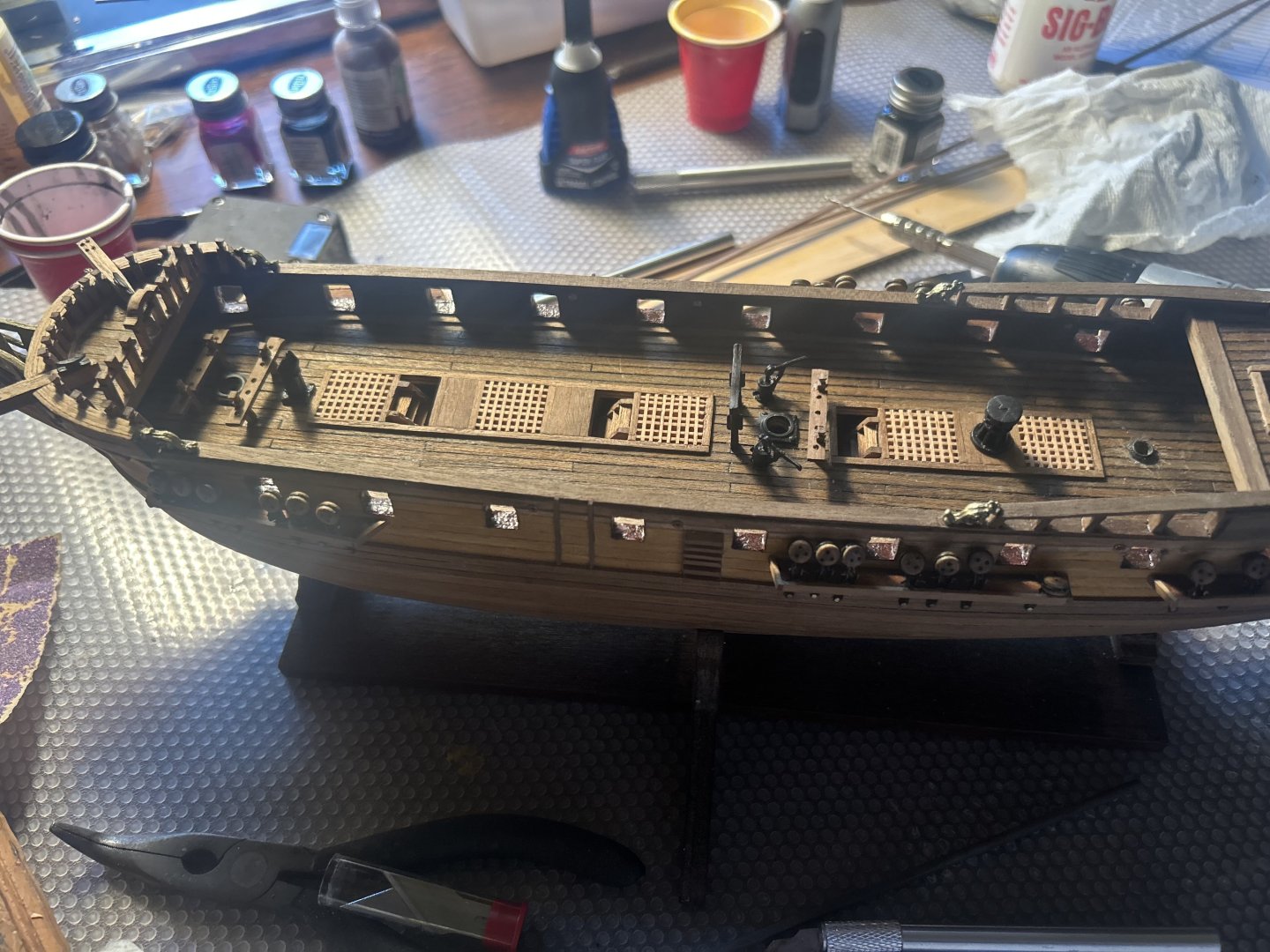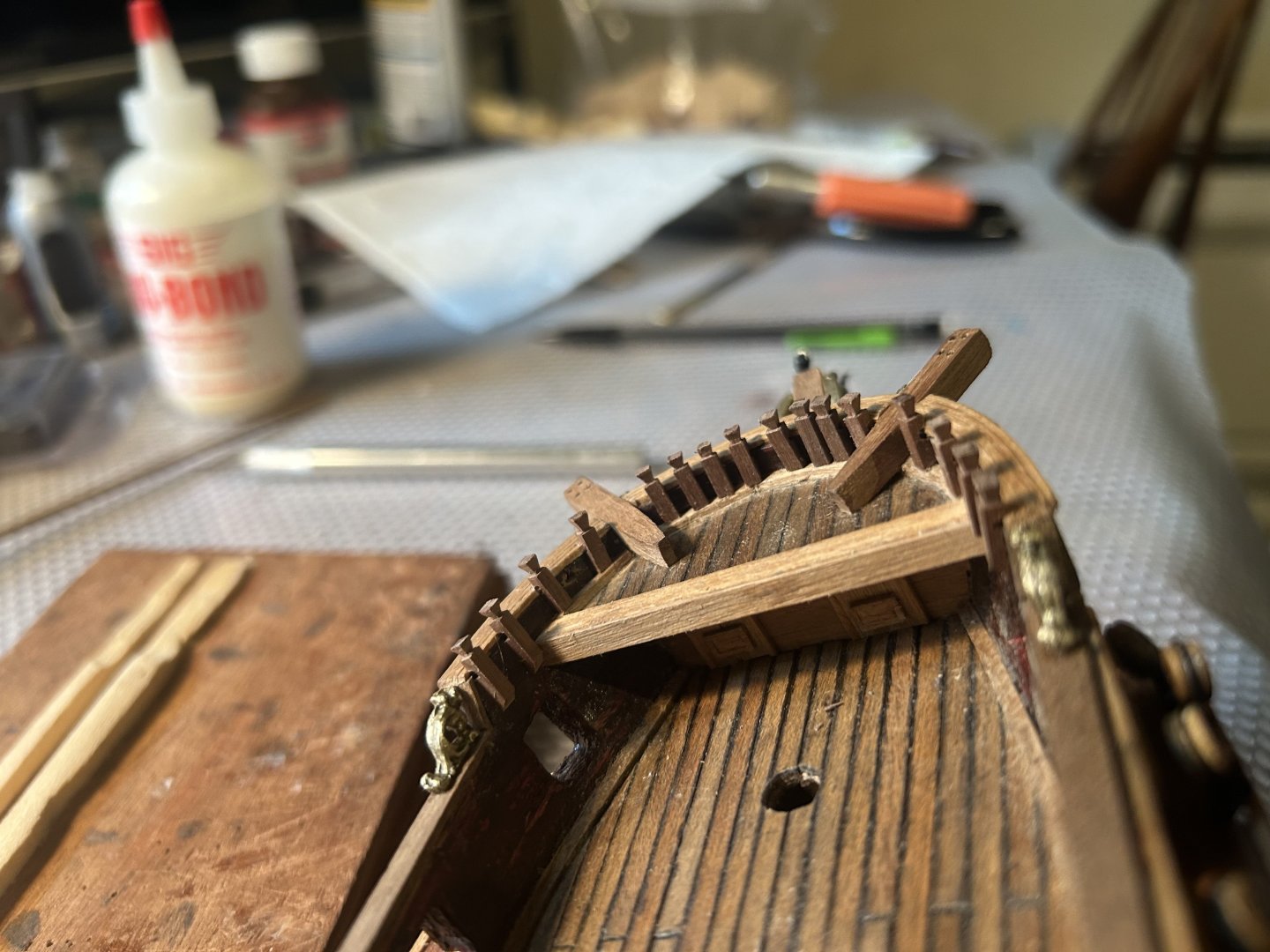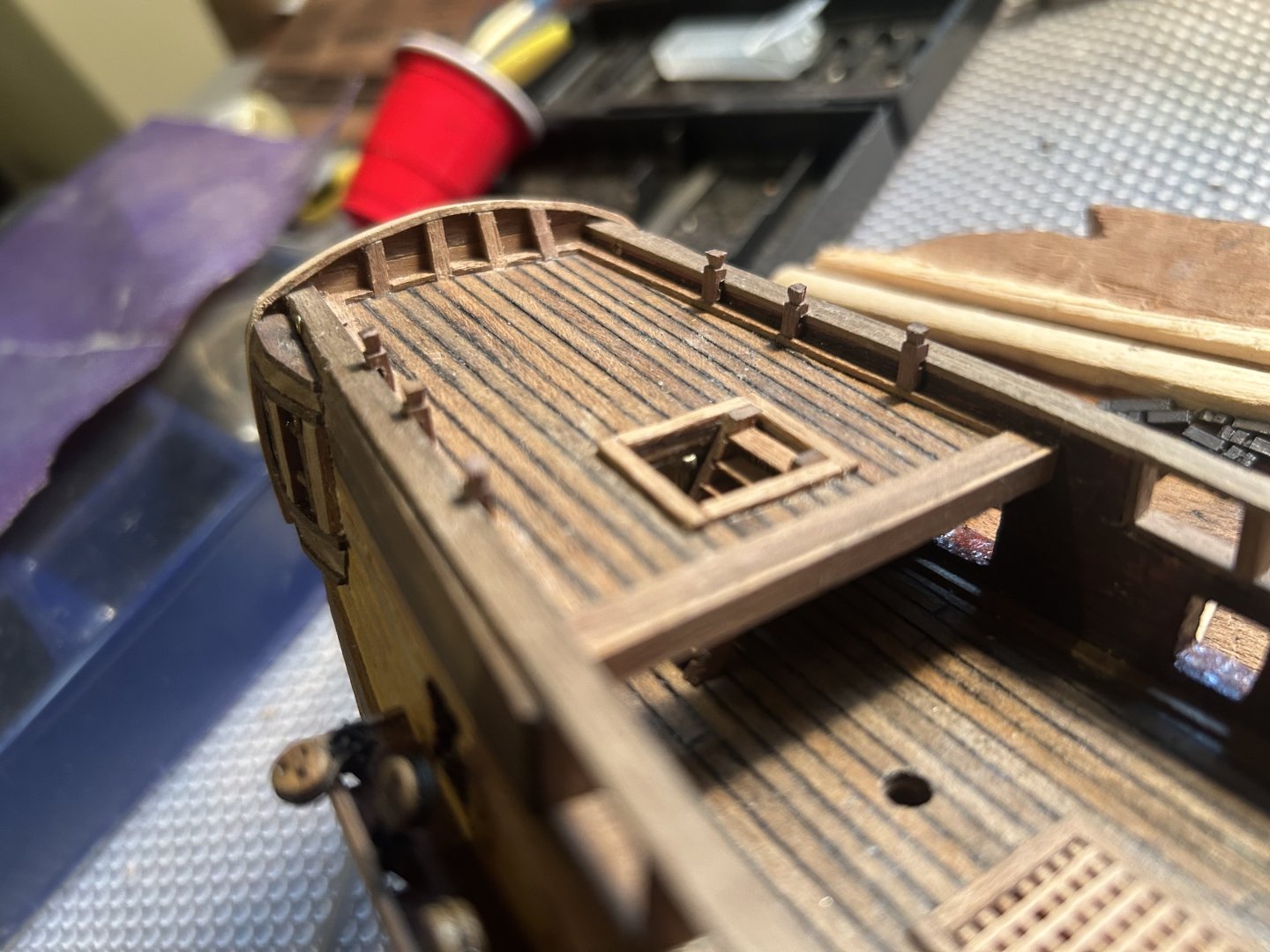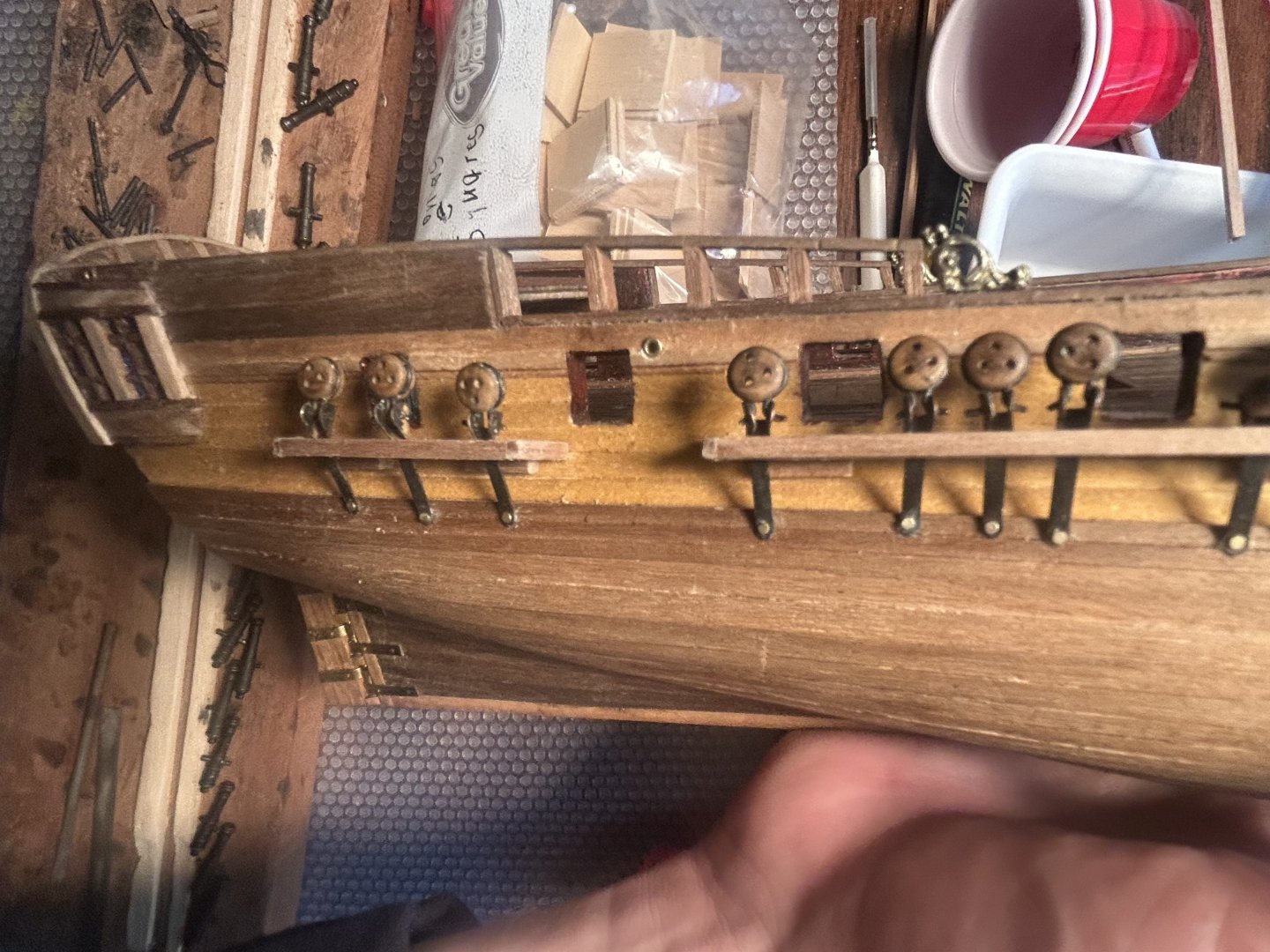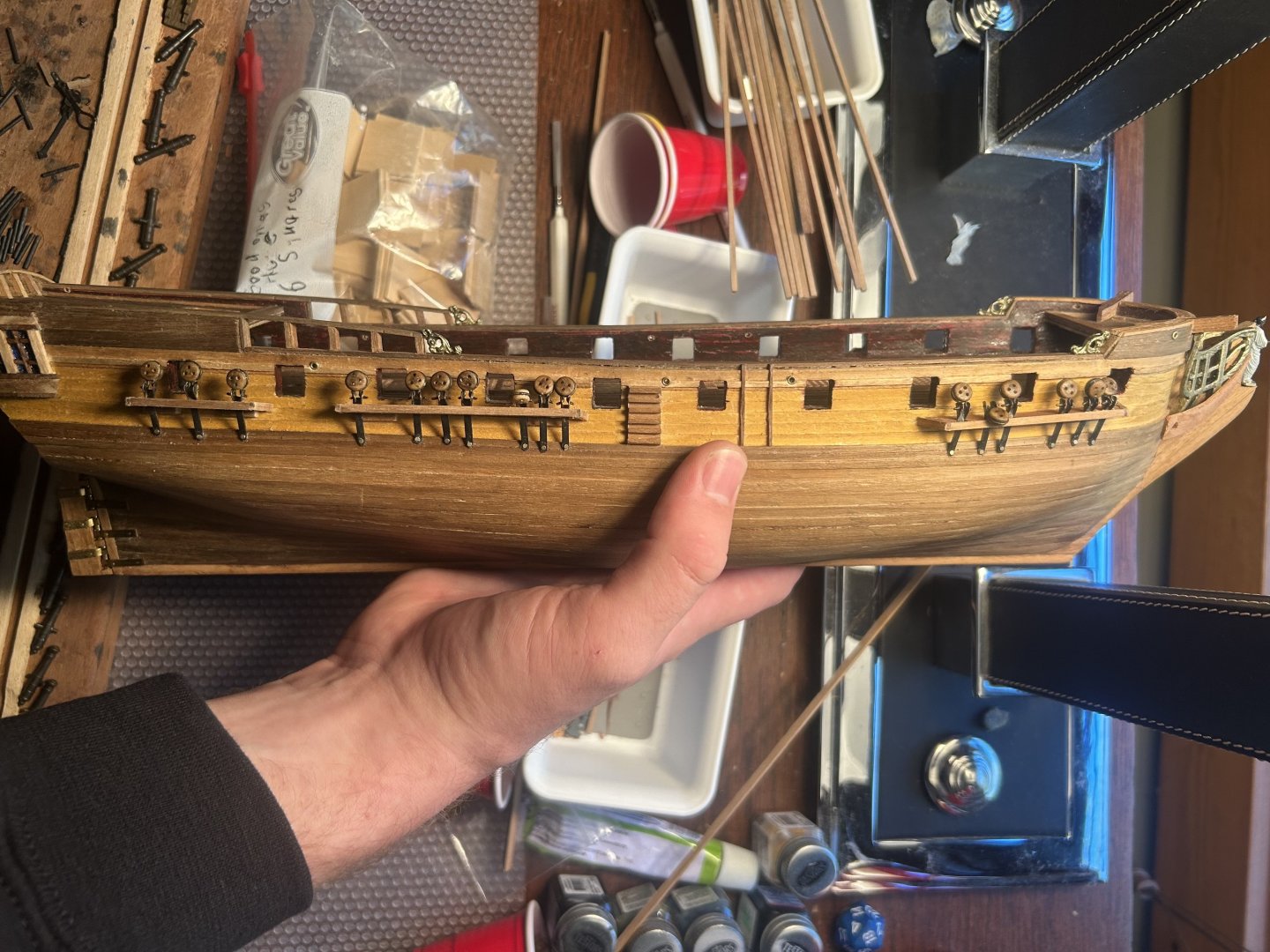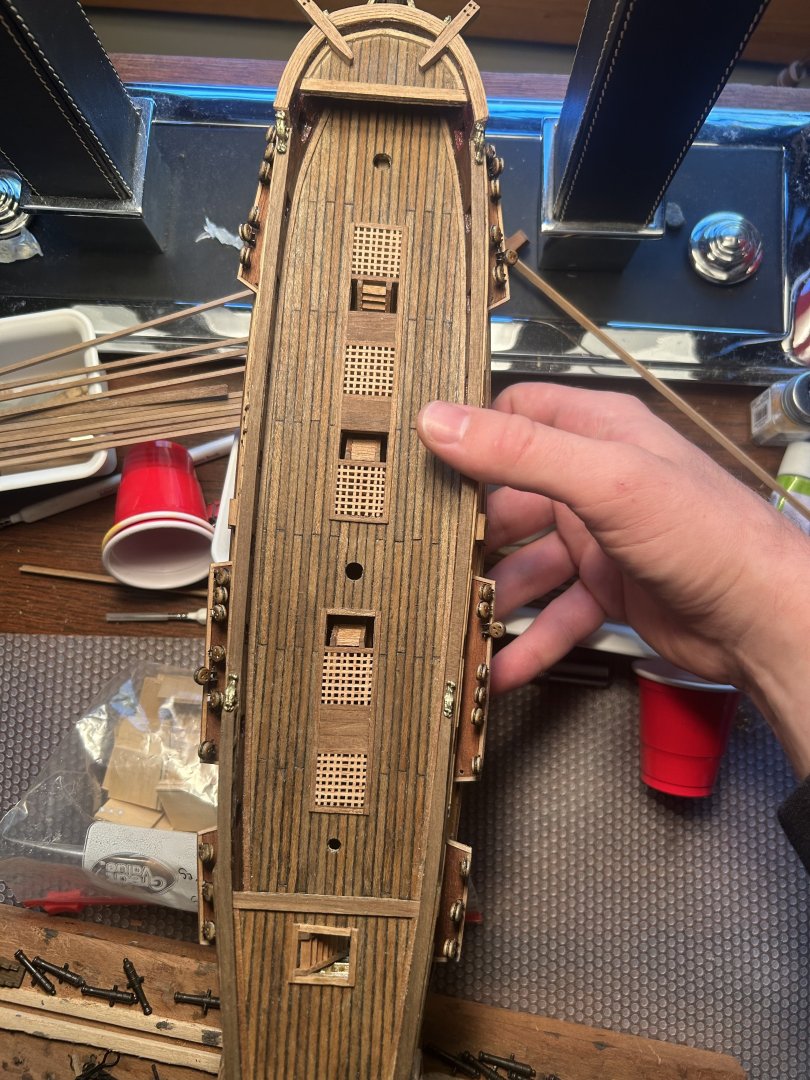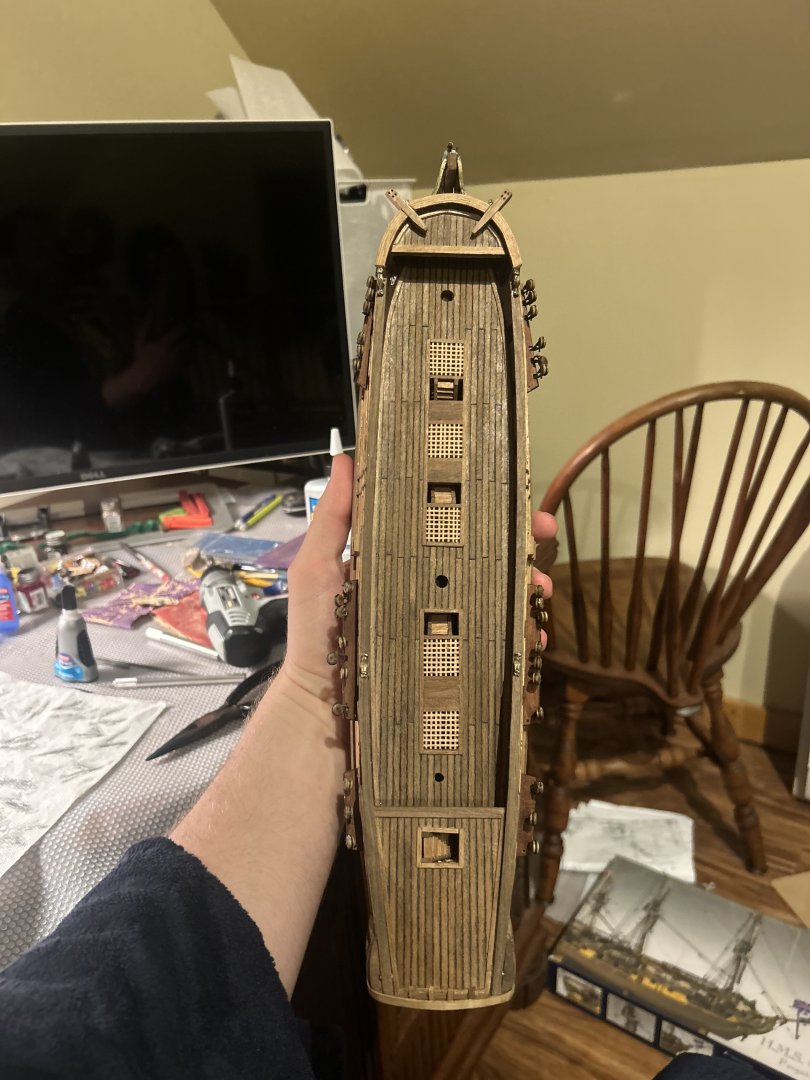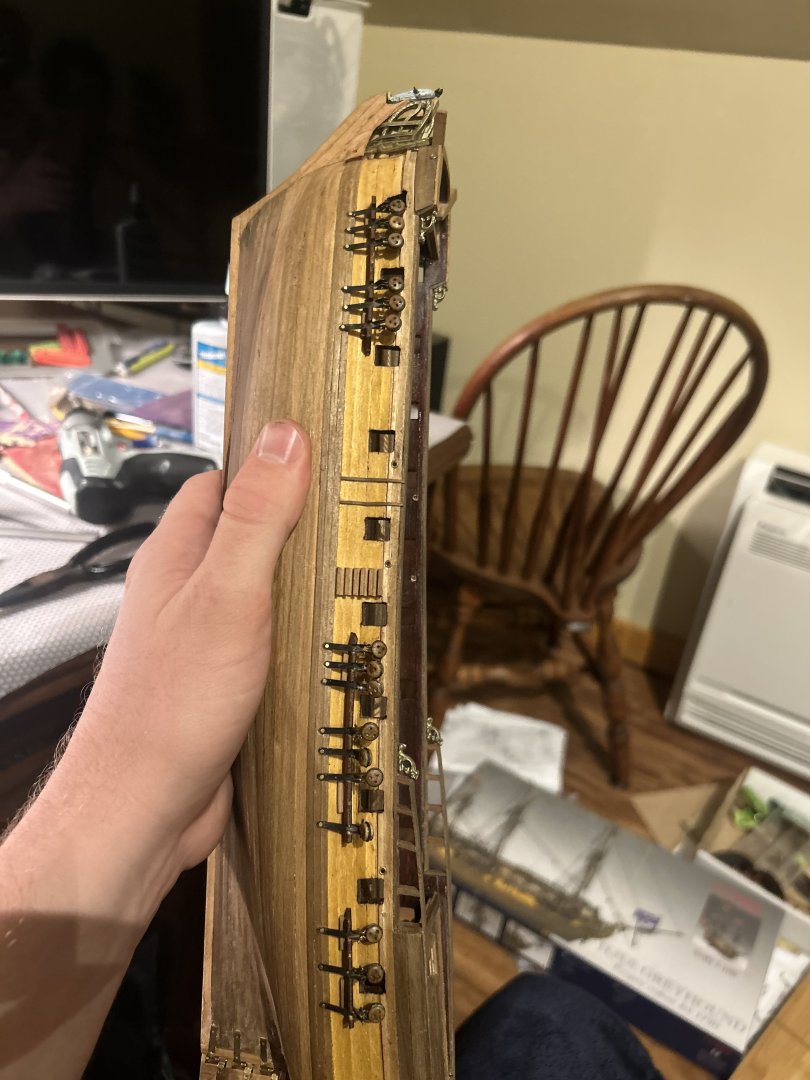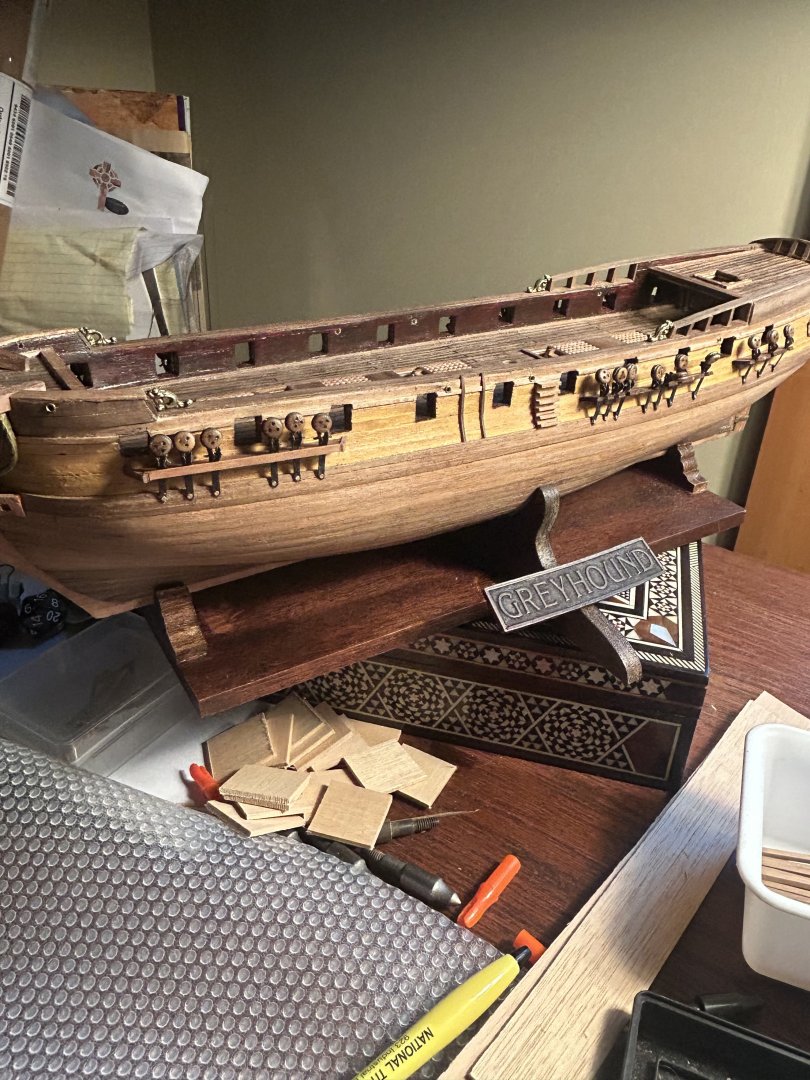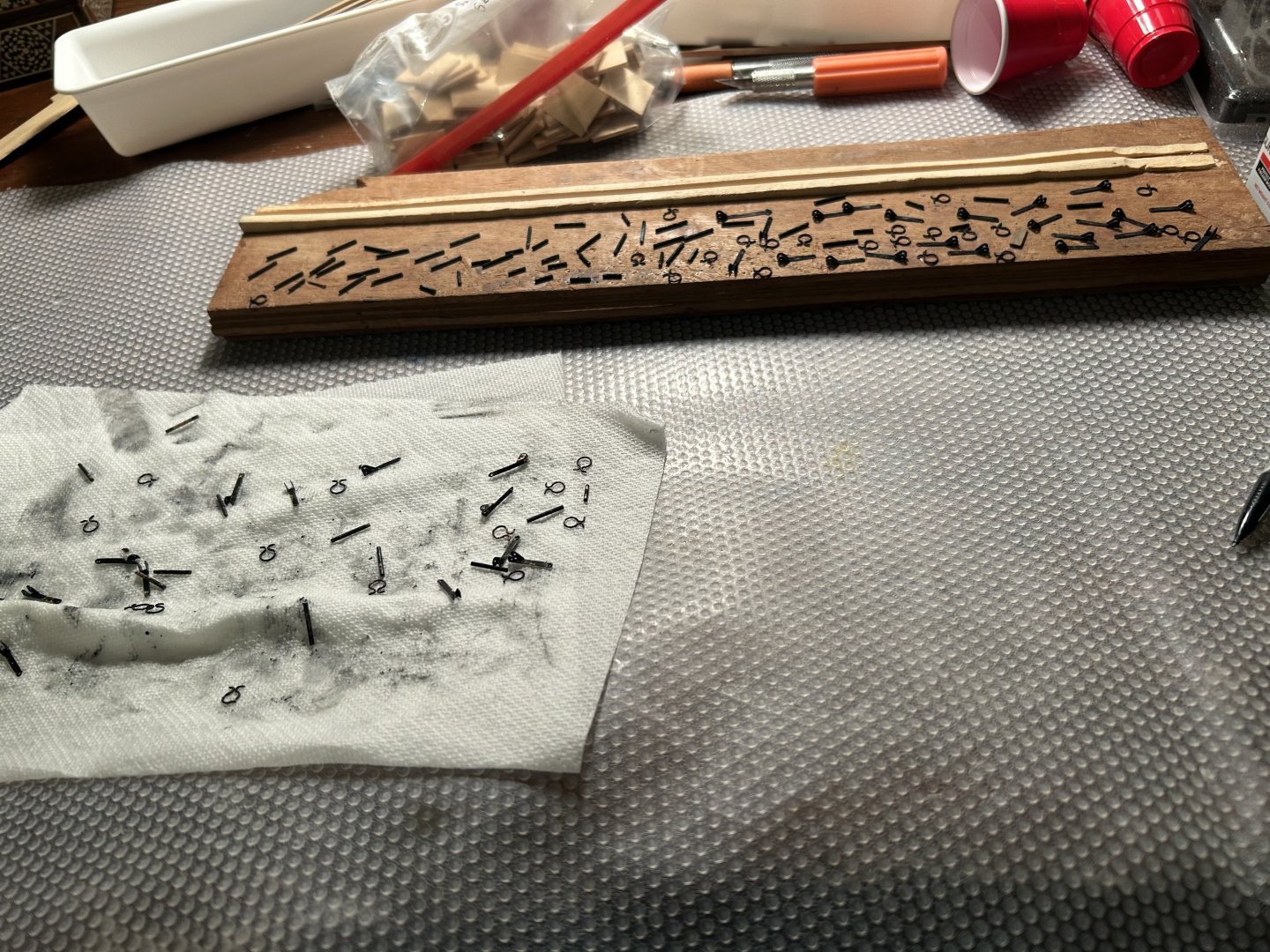
Jackson7
Members-
Posts
182 -
Joined
-
Last visited
Recent Profile Visitors
-
 GrandpaPhil reacted to a post in a topic:
HMS GREYHOUND by Jackson7 - Corel - Collaboration With My Past Self
GrandpaPhil reacted to a post in a topic:
HMS GREYHOUND by Jackson7 - Corel - Collaboration With My Past Self
-
 ccoyle reacted to a post in a topic:
HMS GREYHOUND by Jackson7 - Corel - Collaboration With My Past Self
ccoyle reacted to a post in a topic:
HMS GREYHOUND by Jackson7 - Corel - Collaboration With My Past Self
-
 Nirvana reacted to a post in a topic:
HMS GREYHOUND by Jackson7 - Corel - Collaboration With My Past Self
Nirvana reacted to a post in a topic:
HMS GREYHOUND by Jackson7 - Corel - Collaboration With My Past Self
-
I was busier than I thought last weekend. Furthermore, I discovered the kit didn't have enough wood for the two 2.5 mm poles that hold the ship's boat. But today, I finally bought the drill bit and the wood for the poles. In the meantime, I cut the wood for the masts. For future Greyhound builders, the masts get virtually no instructions or measurements in the packet. That's why you should go to the large diagram labelled SM59 Tav. 3. This exact-sized diagram should allow you to figure out the lengths of all the pieces for this step. It looks like this: The kit also won't mention that every mast and spar is designed to taper gently from bottom to top. This tapering allows the mast pieces to actually fit together, and the yards to look prettier. So far, I've tapered everything on the bowsprit. The next step is to taper the other masts. When the sanding to shape is done, I'll use wood stain to give the masts an appropriate color. This step will take a long time and it won't provide many good pictures, so I won't be updating for a while.
- 213 replies
-
 GrandpaPhil reacted to a post in a topic:
HMS GREYHOUND by Jackson7 - Corel - Collaboration With My Past Self
GrandpaPhil reacted to a post in a topic:
HMS GREYHOUND by Jackson7 - Corel - Collaboration With My Past Self
-
 Jackson7 reacted to a post in a topic:
HMS GREYHOUND by Jackson7 - Corel - Collaboration With My Past Self
Jackson7 reacted to a post in a topic:
HMS GREYHOUND by Jackson7 - Corel - Collaboration With My Past Self
-
 Nirvana reacted to a post in a topic:
HMS GREYHOUND by Jackson7 - Corel - Collaboration With My Past Self
Nirvana reacted to a post in a topic:
HMS GREYHOUND by Jackson7 - Corel - Collaboration With My Past Self
-
Progress proceeds once more, but with a setback that will delay much further operation until Sunday. I've attached the quarterdeck rail. This step looks particularly elegant. At the same time, it's puzzling to see how two pieces of wood can be made to fit together so precisely. As usual, the answer is that these things are simpler than they appear. I made the rail by using a template made of some of my scrap wood. It was a simple matter of drilling holes in the template two mm from its edge, then putting it on top of both pieces to guide the drill. After that and a few gentle nudges, the metal pillars perfectly connected the two wood pieces. All that was left was to put a little slice of veneer scrapwood over the top to hide the holes. I was working on the six brass pieces to the side of the ship. I'm not sure what they're called because Corel's instructions don't mention them. As they are too weak to be pushed into the side like a nail, I was drilling holes for them, and my smallest drill bit broke with four more to go. I'll be buying a new one Sunday at my local hobby store.
- 213 replies
-
 GrandpaPhil reacted to a post in a topic:
HMS GREYHOUND by Jackson7 - Corel - Collaboration With My Past Self
GrandpaPhil reacted to a post in a topic:
HMS GREYHOUND by Jackson7 - Corel - Collaboration With My Past Self
-
It's intriguing how many different skills building a ship involves. Putting deck furnishings on is radically different from assembling planking. Both require precision, but the precision of sanding a plank to fit bears little resemblance to placing a knighthead or drilling a hole. So far, the deck is far less trouble. At this point, I've glued on the cannons, wrapped the wheel in rope, and thanks to @harlequin's advice, I've been able to put all the cleat hitches in place. The kit's drawings require 14 cleat hitches, and the kit only provides 12. I dread to consider how I will do the masts and yards from drawings that just don't work. They are fast approaching. While gluing the cannons on, I discovered they often aren't quite even. I fixed the problem by running them over light sandpaper until the wheels were all level. It's hardly noticeable, and having four glued points of contact on the deck is a great benefit to their long-term stability. I assumed Corel's instructions were right, so my forward deck knightheads were slightly too wide to fit the foremost two guns. Don't believe the manufacturer on this model. Instead, carefully evaluate everything they show in pictures of the ship and reason out how it all ought to fit together. Measure distances yourself. The last thing to do is the rail on the quarterdeck. I've measured everything, and I'm going to start drilling holes to slot the pillars into soon. It will be finnicky to slot six different apertures together into two seperate pieces of wood, but I think I've got it. A note to other beginners: The best way to do deck furnishings is to start at the lowest area. Finish it, move higher, and don't touch the places you've already completed. Also, build the complex stuff first. You're more likely to accidentally break an easy deck fixture while working on a difficult one than to do it the other way around. I found myself wishing there had been some way to complete the main deck before putting on the quarterdeck. It was endless trouble to drill and stab holes for the ship's wheel underneath a roof.
- 213 replies
-
 GrandpaPhil reacted to a post in a topic:
HMS GREYHOUND by Jackson7 - Corel - Collaboration With My Past Self
GrandpaPhil reacted to a post in a topic:
HMS GREYHOUND by Jackson7 - Corel - Collaboration With My Past Self
-
 GrandpaPhil reacted to a post in a topic:
HMS GREYHOUND by Jackson7 - Corel - Collaboration With My Past Self
GrandpaPhil reacted to a post in a topic:
HMS GREYHOUND by Jackson7 - Corel - Collaboration With My Past Self
-
 ccoyle reacted to a post in a topic:
HMS GREYHOUND by Jackson7 - Corel - Collaboration With My Past Self
ccoyle reacted to a post in a topic:
HMS GREYHOUND by Jackson7 - Corel - Collaboration With My Past Self
-
 ccoyle reacted to a post in a topic:
HMS GREYHOUND by Jackson7 - Corel - Collaboration With My Past Self
ccoyle reacted to a post in a topic:
HMS GREYHOUND by Jackson7 - Corel - Collaboration With My Past Self
-
Also, I found a picture of a model of the Greyhound made at the time of its actual existence. While it looks somewhat like the Corel kit, there are several big differences. For a start, the foremost aperture in the hull doesn't have a cannon in it, and it has an additional stern gunport with a cannon extremely near the cabin window. You can clearly see the oar ports above the gunwale. There aren't any roped-off walkways on deck. I'm sure you guys can spot more. https://live.staticflickr.com/65535/50950227046_c02a816bd9_b.jpg
- 213 replies
-
I ran into a bit of trouble. The good news is I was able to put the wheel on and add in all the belaying pins. I accidentally broke off the mast base near the wheel, and it's such a bother than I plan to put it onwhile it's around the mast. I'd recommend doing this step (or at least drilling the holes for it) before putting the quarter deck on. I had to use a thumb tack to press holes in the hull where a drill couldn't reach. The bad news is that I kinda damaged my work on the top deck trying to put in railings. And then I discovered that there's no way they are comfortably at 1/100 scale. I've calculated that they would be nearly 5 feet high. Rope railings at neck level are uncomfortable at best. At worst, they're a way to combine strangulation with falling down the stairs. Given that I doubt my ability to drill holes to contain them and that they are too big, I'm just going to eschew railings. Safety regulations were probably not high on the priority list in 1720 anyway.
- 213 replies
-
Sometimes it's the little things that make a ship come together. I bought some 3 mm high letters from Walmart to put the name on the stern. After some cleaning, sanding and painting, they were ready to place on. They give the stern that last little spark of color it needs to work. I've discovered that the bow might be too crowded to fit the front two guns. I might be able to work around it, but it's likely I'm making an 18-gun ship. No big deal though.
- 213 replies
-
Why work from a kit when you can take four times as long doing it yourself? Slowly, carefully, I have carved wooden deck pieces for every parrt I've felt capable of carving. It's worked great. They look way better. Putting into the deck was frightening. I drilled hoes in the deck where they attached, then carved the ends of the square pegs into circular shapes. They went into the holes fairly easily. It was much better than trying to carve square holes to put them into. Now, I have just the back rail and the little railings for the stairs.
- 213 replies
-
When the metal bannister provided by the kit didn't fit, I built my own. It may be the best bit of carving I've done yet on this insane project. It looks far more natural than the original. Now, I just have the other railing and all the wood knighthead things in the center. We'll see just how they go.
- 213 replies
-
I settled on carving the knightheads myself. Now, 22 tiny carved knightheads later, I'm done with all the ones that attach to the rail. Of course, the metal front railing doesn't fit, so I'm carving that too. And I'm probably going to carve the 8 additional knightheads that go near the masts. They're simple to do. All you need is a sharp X-Acto knife and a lot of persistence. I also put a thin veneer over the false deck at the bow and the stern. It looks much better. Hopefully this phase will go much more quickly after I'm done with the ridiculous amounts of tiny carvings. At least I've preemptively assembled the gun carriages. Also, if anyone can provide photos of where all the cleat hitches attach, I would be very grateful. I don't trust the kit drawings at this point.
- 213 replies
-
I've passed a milestone. Every piece of wood that remains to be glued onto the ship is either a deck furnishing or part of the masts. I have realized that for the deck furnishings, I'm better off carving my own knight heads from 2mm by 2mm than using the kit's metal ones. It will be just as much trouble to cut metal to shape as to cut wood to shape. Before I begin that arduous task, I'm gluing the gun carriages together. So far, they're looking great. Blackened brass was the way to go.
- 213 replies
-
Good to know. You're right, there's really nothing for it now. There's so much to learn on this ship.
- 213 replies
-
I've successfully attached the chainwales and deadeyes to the ship. After coating them in some protective metal wax, they look almost exactly as I hoped. To avoid splitting the gunwale wood, I drilled tiny holes for the nails to enter. Right now, I still need to put on the wood that holds them in place. I think they're going to be the last wood I need to glue onto the outside hull.
- 213 replies
-
Hey y'all, I've returned at last. I didn't like the brightness of the brass on many of the ship's pieces, so I blackened them all with Birchwood Casey Brass Black. It generated a cleaner result than painting them. The process was arduous. I cleaned them off with steel wool and denatured alcohol, soaked them briefly in brass black, let them dry, then coated them all with Birchwood Casey gun stock wax. The resulting color is impressively solid, and it's not worth going back to fix the few small problems. If someone else chooses to use this method, they should blacken the brass in small batches. I think that gives a better result.
- 213 replies
-
I finished cutting out new bow pieces. They only have one hole, but that's because they broke while I was drilling the hole out. They were so much work and so risky to createthat it wasn't worth it to take another attempt.
- 213 replies
-
I'm working on the task of cutting out two new bow pieces. With a great degree of effort, I've succeeded in carving a piece of wood from my cutting board to the right shape. With two more cuts, I'll have the shape correct.
- 213 replies
About us
Modelshipworld - Advancing Ship Modeling through Research
SSL Secured
Your security is important for us so this Website is SSL-Secured
NRG Mailing Address
Nautical Research Guild
237 South Lincoln Street
Westmont IL, 60559-1917
Model Ship World ® and the MSW logo are Registered Trademarks, and belong to the Nautical Research Guild (United States Patent and Trademark Office: No. 6,929,264 & No. 6,929,274, registered Dec. 20, 2022)
Helpful Links
About the NRG
If you enjoy building ship models that are historically accurate as well as beautiful, then The Nautical Research Guild (NRG) is just right for you.
The Guild is a non-profit educational organization whose mission is to “Advance Ship Modeling Through Research”. We provide support to our members in their efforts to raise the quality of their model ships.
The Nautical Research Guild has published our world-renowned quarterly magazine, The Nautical Research Journal, since 1955. The pages of the Journal are full of articles by accomplished ship modelers who show you how they create those exquisite details on their models, and by maritime historians who show you the correct details to build. The Journal is available in both print and digital editions. Go to the NRG web site (www.thenrg.org) to download a complimentary digital copy of the Journal. The NRG also publishes plan sets, books and compilations of back issues of the Journal and the former Ships in Scale and Model Ship Builder magazines.

